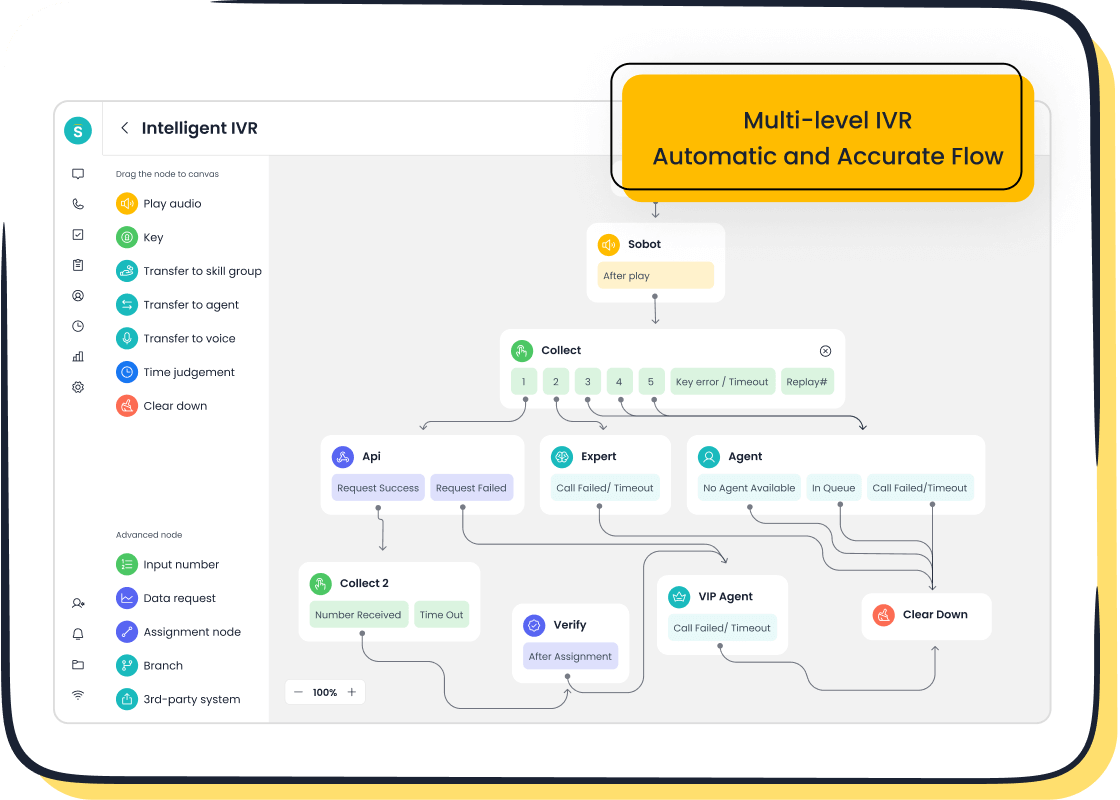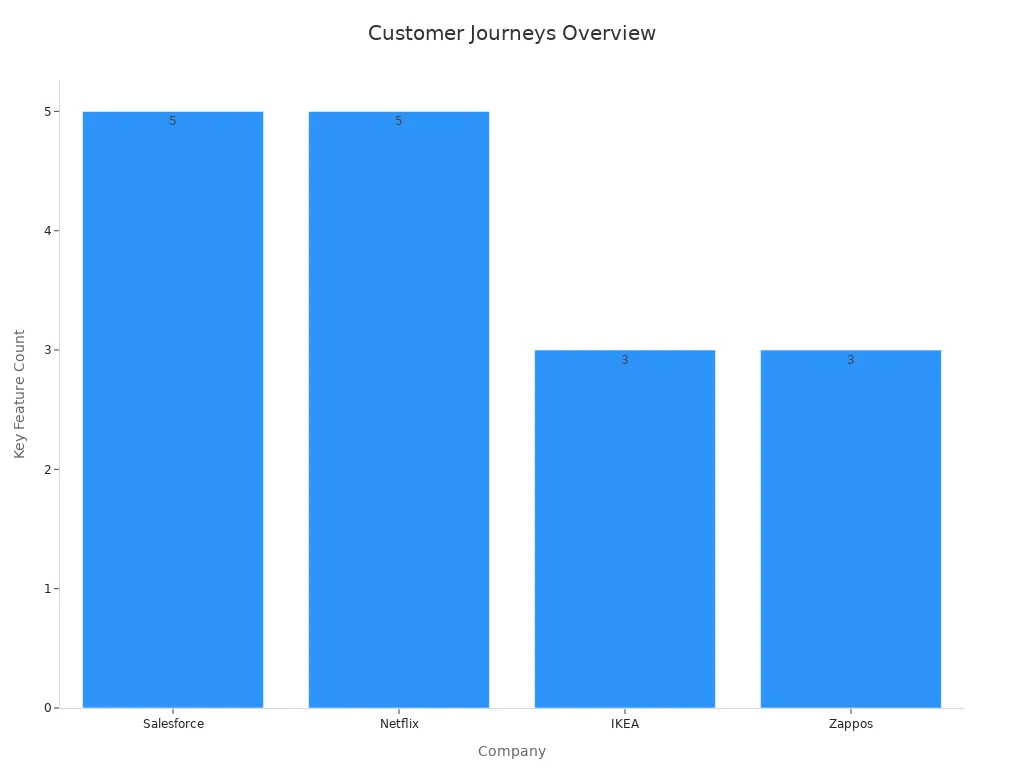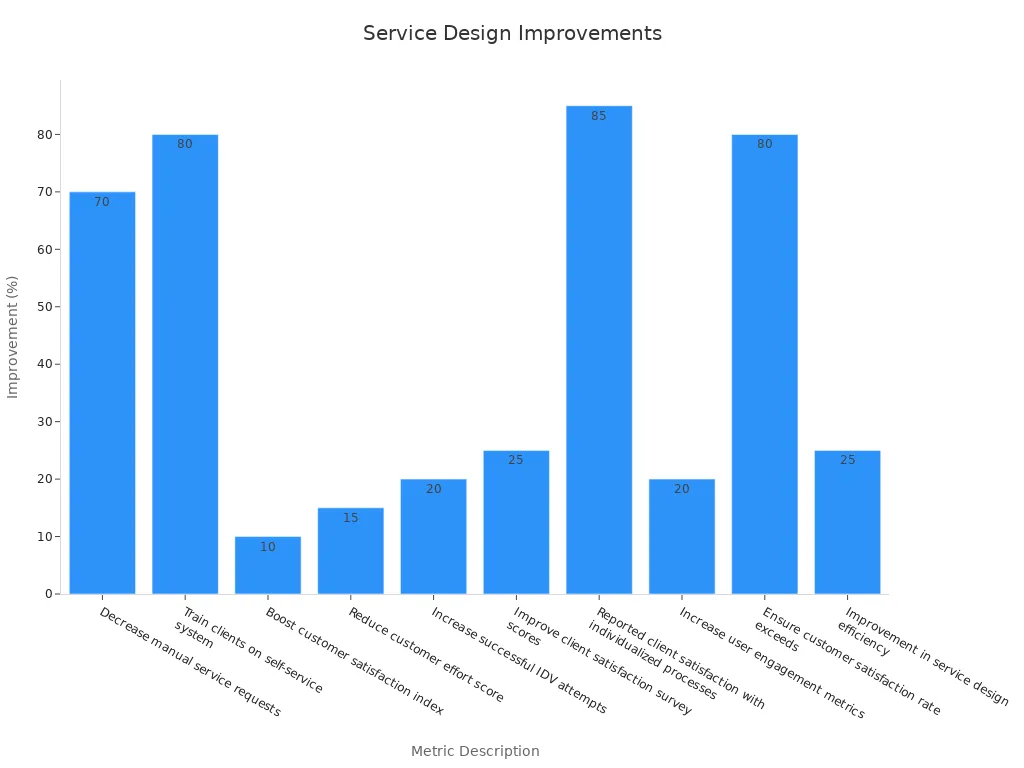What Is Customer Journey Management and How It Differs

What is customer journey management? It is the process of understanding and optimizing how customers interact with your brand across various touchpoints. This approach focuses on addressing customer expectations, pain points, and challenges throughout their experience. In contrast, service design emphasizes improving internal processes to ensure seamless and efficient customer interactions. While customer journey management prioritizes the customer’s perspective, service design is centered on operational optimization.
Businesses that invest in enhancing customer experiences reap significant rewards. For instance, customer-centric brands achieve 60% higher profits, and 84% of companies prioritizing customer experience report increased revenue. Tools like Sobot’s omnichannel solutions play a crucial role in simplifying customer interactions, enabling businesses to meet customer expectations effectively and drive improvements across all touchpoints.
What Is Customer Journey Management?

Definition and Purpose of Customer Journey Management
Customer journey management is the process of understanding, analyzing, and optimizing the interactions your customers have with your brand across various touchpoints. It focuses on creating seamless experiences that meet customer expectations while addressing pain points. By managing the journey effectively, you can foster stronger relationships, improve satisfaction, and drive loyalty.
The purpose of customer journey management is to ensure every interaction aligns with your customers' needs and preferences. This approach emphasizes personalization, proactive engagement, and customer empowerment. For example, businesses that prioritize customer journey mapping report significant benefits. Statistics show that 87% of companies use their understanding of the customer journey as a decision-making tool, while 91% report increased sales due to improved customer experiences.
Key Components of Customer Journey Management
Effective customer journey management relies on several key components:
- Customer Journey Mapping: This involves visualizing the steps your customers take when interacting with your brand. It helps identify friction points and opportunities for improvement.
- Personalization: Tailoring experiences to individual customer preferences enhances satisfaction and loyalty.
- Metrics and Analytics: Tracking metrics like conversion rates, Net Promoter Scores (NPS), and customer lifetime value (CLV) provides insights into the effectiveness of your strategies.
- Proactive Engagement: Anticipating customer needs and addressing them before they arise builds trust and reduces churn.
Leading companies measure these components to refine their strategies. For instance, conversion rates indicate how effectively your journey encourages desired actions, while NPS reflects customer loyalty.
| Key Component | Description |
|---|---|
| Conversion Rate | Percentage of users completing a desired action out of total visitors, indicating effectiveness. |
| Customer Loyalty | Likelihood of repeat business and customer satisfaction levels. |
| Net Promoter Score (NPS) | Measures customer loyalty by asking about the likelihood of recommending the brand. |
| Customer Lifetime Value (CLV) | Revenue generated over the entire lifecycle of a customer’s relationship with a company. |
The Role of Customer Journey Maps in Journey Management
Customer journey maps play a crucial role in managing and improving customer experiences. These maps provide a visual representation of the steps your customers take, from initial awareness to post-purchase interactions. By identifying pain points and opportunities, you can create strategies that enhance satisfaction and streamline processes.
Quantitative evidence supports the effectiveness of customer journey maps. Surveys show that businesses using journey maps can pinpoint service gaps and prioritize improvements. Metrics like NPS and customer satisfaction scores highlight areas where interactions can be optimized. For example, a healthcare provider achieved a 156% increase in consultation bookings by using emotional journey mapping and targeted content.
| Case Study | Key Results | Strategies Implemented |
|---|---|---|
| E-Commerce Retailer | 341% increase in conversion rate | Journey mapping, friction analysis, personalized messaging |
| B2B Software Company | 287% increase in lead-to-customer conversion | Persona-based paths, content alignment, journey-based nurturing |
| Financial Services Firm | 203% increase in completed mobile applications | Mobile journey optimization, progressive form design, contextual help |
| Retail Brand | 178% increase in cross-channel revenue | Omnichannel journey orchestration, unified customer recognition |
| Healthcare Provider | 156% increase in consultation bookings | Emotional journey mapping, fear-reducing interactions, targeted content |

Sobot’s solutions, such as its Voice/Call Center and Omnichannel Solution, simplify customer journey mapping by providing unified workspaces and actionable insights. These tools help you track customer interactions, analyze data, and implement personalized strategies that drive better outcomes.
Examples of Customer Journey Management in Action
Customer journey management tools have transformed how businesses interact with their customers. By focusing on the entire journey, companies can create seamless experiences that build loyalty and satisfaction. Let’s explore some real-world examples of successful implementations:
| Company | Implementation Example | Key Features |
|---|---|---|
| Salesforce | B2B Customer Implementation Journey | Multi-stakeholder tracking, implementation milestone mapping, ROI realization touchpoints, user adoption tracking, success metrics, and feedback loops |
| Netflix | Personalized Content Discovery Journey | Recommendation algorithm touchpoints, cross-device viewing continuity, content format testing, binge-watching behavior tracking, viewing context segmentation |
| IKEA | Furniture Buying Journey Map | Improved assembly instructions, development of the IKEA Place AR app, creation of kitchen planning service |
| Zappos | Customer Service Journey Map | Empowering employees, creating memorable service interactions, focus on customer experience |
These examples highlight how customer journey mapping can address specific challenges. For instance, Netflix uses advanced algorithms to recommend content based on your viewing habits, ensuring a personalized experience. IKEA’s journey map focuses on simplifying the furniture-buying process, from assembly instructions to augmented reality tools like the IKEA Place app. Zappos, on the other hand, empowers its employees to deliver exceptional service, creating memorable interactions that enhance customer satisfaction.

These examples demonstrate the power of customer journey management tools in improving customer experiences. By leveraging journey mapping, companies can identify pain points, streamline processes, and deliver value at every touchpoint.
How Sobot’s Voice/Call Center Enhances Customer Journey Management

Sobot’s Voice/Call Center stands out as a powerful tool for enhancing customer journey management. It combines advanced features with AI-driven efficiency to optimize every interaction. Here’s how it makes a difference:
- AI-driven efficiency: The platform uses artificial intelligence to track agent adherence, optimize shift scheduling, and improve operational efficiency. This ensures your customers receive timely and effective support.
- Reduced waiting times: Smart integrations have cut waiting times by 35%, allowing your customers to connect with agents faster.
- Omnichannel solutions: By integrating with Sobot’s omnichannel solutions, the Voice/Call Center eliminates disjointed systems. This creates a unified experience for your customers, whether they contact you via phone, email, or chat.
For example, a major fresh food e-commerce company used Sobot’s Voice/Call Center to streamline its customer interactions. The result? Reduced waiting times and improved satisfaction scores. These features make Sobot’s tools indispensable for businesses aiming to enhance their customer journey management strategies.
By using Sobot’s Voice/Call Center, you can leverage customer journey mapping to its fullest potential. The platform provides actionable insights, enabling you to refine your strategies and deliver exceptional experiences at every stage of the journey.
What Is Service Design?
Definition and Purpose of Service Design
Service design focuses on creating and improving services to ensure they meet your needs as a customer. It involves planning and organizing resources, processes, and interactions to deliver seamless and efficient experiences. Unlike customer journey management, which emphasizes your perspective, service design prioritizes the internal workings of a business to support those experiences.
The purpose of service design is to align every aspect of a service with its goals. For example, a well-designed service ensures that employees understand their roles, processes run smoothly, and customers receive consistent quality. Companies that invest in service design projects often see improvements in operational efficiency and customer satisfaction. A logistics company, for instance, might redesign its delivery process to reduce delays and enhance communication with customers.
Key Components of Service Design
Effective service design relies on several key components that work together to create a cohesive system:
- Service Design Map: This visual tool outlines the relationships between different service elements, helping you identify gaps and opportunities for improvement.
- Customer-Centric Approach: Designing services with your needs in mind ensures a better experience.
- Collaboration: Teams across departments must work together to align processes and goals.
- Prototyping and Testing: Testing new ideas before full implementation helps refine services.
These components ensure that service design projects address both customer expectations and business objectives. For example, prototyping a new checkout process in retail can reveal potential issues before it goes live.
The Role of Service Blueprints in Service Design
A service blueprint is a powerful tool that maps out all the components and processes involved in delivering a service. It provides a clear picture of how front-end interactions connect with back-end operations. By using a service blueprint, you can identify inefficiencies, set performance metrics, and improve service delivery.
Metrics like customer satisfaction, operational efficiency, and service quality help evaluate the effectiveness of a blueprint. For instance, a company might use surveys to gather feedback on how well the blueprint aligns with customer needs. Tracking employee engagement and analyzing service efficiency can also highlight areas for improvement.
To create a successful service blueprint, businesses often:
- Conduct surveys to assess its clarity and usefulness.
- Monitor changes in service delivery and customer experiences.
- Analyze data on cost-effectiveness and efficiency.
- Measure increases in employee engagement and role clarity.
By implementing service blueprints, companies can enhance service design projects and deliver better experiences. Sobot’s omnichannel solution, for example, integrates seamlessly with service blueprints to unify customer interactions and improve operational efficiency.
Examples of Service Design in Action
Service design has transformed how businesses deliver value to their customers. By focusing on improving internal processes, companies have achieved remarkable results. For example, organizations that implemented service design strategies reported significant improvements in efficiency and satisfaction metrics.
| Metric Description | Improvement Percentage |
|---|---|
| Decrease manual service requests | 70% |
| Train clients on self-service system | 80% |
| Boost customer satisfaction index | 10% |
| Reduce customer effort score | 15% |
| Increase successful IDV attempts | 20% |
| Improve client satisfaction survey scores | 25% |
| Reported client satisfaction with individualized processes | 85% |
| Increase user engagement metrics | 20% |
| Ensure customer satisfaction rate exceeds | 80% |
| Improvement in service design efficiency | 25% |

One example involves a financial services firm that redesigned its onboarding process. By introducing a self-service portal, the firm reduced manual requests by 70% and improved customer satisfaction by 10%. Another case highlights a retail company that streamlined its checkout process, leading to a 15% reduction in customer effort scores. These examples demonstrate how service design can enhance both operational efficiency and customer experiences.
How Sobot’s Omnichannel Solution Supports Service Design
Sobot’s Omnichannel Solution plays a pivotal role in supporting service design. It integrates multiple communication channels into a unified platform, ensuring seamless interactions for your customers. This solution simplifies internal workflows, enabling your team to deliver consistent and efficient service.
Key features of Sobot’s Omnichannel Solution include AI-driven automation, a unified workspace, and advanced analytics. These tools help you manage customer interactions across channels like email, chat, and social media. For instance, the unified workspace consolidates customer data, allowing agents to provide personalized support. The analytics feature offers insights into performance metrics, helping you identify areas for improvement.
By adopting Sobot’s Omnichannel Solution, you can enhance service design efficiency by 25% and ensure customer satisfaction rates exceed 80%. This solution empowers your team to focus on meaningful interactions, reducing repetitive tasks and improving overall service quality. Whether you operate in retail, financial services, or gaming, Sobot’s tools adapt to your unique needs, driving better outcomes for your business.
Key Differences Between Customer Journey Management and Service Design

Goals and Objectives
Customer journey management and service design differ significantly in their goals and objectives. Customer journey management focuses on improving the customer experience by addressing pain points and enhancing satisfaction across all touchpoints. It aims to create seamless interactions that foster loyalty and retention. For example, customer journey mapping helps you visualize the steps customers take, revealing opportunities to improve their experience. Aligning these goals with service design ensures both functions work toward common targets like customer satisfaction and retention.
On the other hand, service design prioritizes optimizing internal processes to support the delivery of exceptional services. Its goal is to ensure that every element of a service, from employee roles to operational workflows, aligns with the desired outcomes. For instance, a logistics company might use a service blueprint to streamline its delivery process, reducing delays and improving communication. By focusing on internal efficiency, service design creates a strong foundation for delivering consistent and high-quality experiences.
Processes and Methodologies
The methodologies used in customer journey management and service design also set them apart. Customer journey management relies heavily on tools like journey maps to analyze and optimize customer interactions. These maps highlight friction points and opportunities for improvement, enabling you to create strategies that address specific challenges. For example, Zappos achieved an NPS above 80 by empowering agents to personalize interactions, eliminating rigid scripts, and focusing on customer needs.
Service design, however, uses service blueprints to map out the relationships between front-end interactions and back-end processes. These blueprints provide a detailed view of how services are delivered, helping you identify inefficiencies and improve workflows. For instance, AXA Insurance redesigned its post-claim process using a service blueprint, which improved customer satisfaction by over 20 points and reduced response times by 30%. Both methodologies have proven success rates, but they serve different purposes—journey maps focus on the customer’s perspective, while blueprints emphasize operational efficiency.
Focus Areas and Perspectives
The focus areas and perspectives of customer journey management and service design further highlight their differences. Customer journey management centers on the customer’s perspective, aiming to create personalized and emotionally engaging experiences. Studies show that emotionally connected customers have 306% more lifetime value than those who are merely satisfied. This underscores the importance of designing interactions that resonate with your audience.
In contrast, service design adopts an internal perspective, focusing on the systems and processes that enable service delivery. It emphasizes collaboration across departments to ensure that every aspect of the service aligns with organizational goals. For example, Telstra reduced early cancellations by 40% by redesigning its installation process and integrating real-time tracking technologies. This internal focus ensures that your team can deliver consistent and efficient services, ultimately supporting the customer journey.
Both approaches address distinct yet complementary aspects of the customer experience. While customer journey management enhances the external experience, service design strengthens the internal framework that supports it. Together, they create a holistic strategy for delivering exceptional value at every touchpoint.
Tools Used: Journey Maps vs. Service Blueprints
When managing customer experiences or designing services, journey maps and service blueprints are indispensable tools. Each serves a distinct purpose, yet both contribute to creating seamless and efficient interactions.
Comparing Journey Maps and Service Blueprints
Journey maps focus on understanding the customer’s experience. They visualize the steps customers take when interacting with your brand, highlighting pain points and opportunities for improvement. For example, a customer journey map might reveal that long wait times during checkout frustrate customers, prompting you to streamline the process.
Service blueprints, on the other hand, delve into the internal operations that support these customer interactions. They map out front-stage and back-stage processes, showing how your team and systems work together to deliver services. For instance, a service blueprint might uncover inefficiencies in order fulfillment, enabling you to optimize workflows and reduce delays.
Here’s a detailed comparison of these tools:
| Aspect | Customer Journey Maps | Service Blueprints |
|---|---|---|
| Focus | Understanding the user's experience | Visual representation of internal operations |
| Key Uses | Identifying areas for improvement, reducing friction | Understanding how the organization supports customer experience |
| Actors | Customers or end-users | Customers, staff, and other actors involved |
| Perspective | End-to-end customer experience narrative | Business processes and operations |
| Actions | Customer actions and some front-stage actions | Front-stage, back-stage, and behind-the-scenes actions |
| When to Use | To gain a broader understanding of customer experience | To investigate behind-the-scenes processes after identifying issues |
Both tools are essential for improving customer experiences. Journey maps help you see the experience through your customer’s eyes, while service blueprints provide a behind-the-scenes look at how your operations support that experience.
Benefits of Using These Tools
- They identify key areas in the customer journey that provide a poor experience.
- They highlight opportunities to improve products or services.
- They reveal inefficiencies in both customer-facing and internal processes.
By leveraging these tools, you can create a comprehensive strategy that addresses both external and internal challenges.
How They Complement Each Other
Journey maps and service blueprints are not standalone tools. They work best when used together, offering a holistic view of the customer experience and the internal processes that support it.
For example, a journey map might show that customers abandon their carts during checkout. A service blueprint can then reveal the root cause, such as a slow payment processing system or unclear instructions. Together, these tools enable you to address the issue from both the customer’s perspective and the operational side.
Using these tools in tandem also drives measurable business improvements. Companies that integrate customer journey insights into their strategic planning often report better decision-making. They can pinpoint what matters most to customers at each interaction point. This approach has led to higher customer satisfaction and retention rates.
By centering your strategy around customer needs, you ensure that your efforts deliver value rather than just meeting internal goals.
Sobot’s solutions, such as its Voice/Call Center and Omnichannel Solution, seamlessly integrate with these tools. For instance, the Voice/Call Center provides actionable insights into customer interactions, helping you refine your journey maps. Meanwhile, the Omnichannel Solution unifies communication channels, making it easier to implement changes identified through service blueprints. These features empower you to enhance both customer experiences and operational efficiency.
By combining journey maps and service blueprints, you can create a customer-centric strategy that addresses every aspect of the experience. This approach not only improves satisfaction but also strengthens your brand’s reputation and drives long-term success.
When to Use Customer Journey Management vs. Service Design
Scenarios for Applying Customer Journey Management
Customer journey management works best when you aim to enhance the end-to-end experience for your audience. It is particularly effective in scenarios where understanding customer behavior and emotions can lead to better outcomes. For example, mapping the five stages of the customer journey—Attention, Interest, Desire, Action, and Loyalty—helps you identify critical touchpoints for improvement. By focusing on these stages, you can amplify positive customer emotions and create memorable interactions.
To apply this approach effectively, follow these steps:
- Frame the Journey Mapping Effort: Assemble a core team and communicate the vision to create urgency.
- Select Journeys to Map: Use both qualitative and quantitative data to assess the impact of specific journeys based on frequency, cost, and revenue potential.
- Integrate Key Performance Indicators (KPIs): Visualize how metrics like Net Promoter Score (NPS) and customer satisfaction influence the journey.
| Phase | Description |
|---|---|
| Frame The Journey Mapping Effort | Assemble a core stakeholder group and communicate the vision. |
| Selecting Journeys to Map | Assess business and customer impact using data and criteria like frequency. |
| Integrate Key Performance Indicators | Incorporate KPIs to visualize their impact on the customer journey. |
By following these steps, you can design products and services that meet your audience's expectations. For instance, identifying high points in the journey allows you to recreate positive interactions, boosting satisfaction and loyalty.
Scenarios for Applying Service Design
Service design is ideal when you need to optimize internal processes to support seamless customer interactions. It is particularly useful in complex systems where multiple teams and workflows intersect. For example, during the development of analytical dashboards, service design methods like user interviews and systems mapping help ensure the final product meets user needs.
At the problem exploration stage, systems mapping identifies stakeholders and workflows. During testing, human-centered design methods uncover user challenges. Finally, service blueprints communicate operational aspects, ensuring all elements align with the service goals. These methods improve efficiency and ensure your team delivers consistent quality.
For instance, a financial services firm used service design to refine its onboarding process. By introducing a self-service portal, the firm reduced manual requests by 70% and improved customer satisfaction by 10%. This example highlights how service design can transform internal workflows while enhancing the customer experience.
Integrating Both for Better Results
Combining customer journey management and service design creates a holistic strategy for delivering exceptional value. Journey maps help you understand the customer’s perspective, while service blueprints reveal inefficiencies in your operations. Together, these tools enable you to address challenges from both angles.
For example, if customers abandon their carts during checkout, a journey map might highlight frustration with the payment process. A service blueprint can then identify the root cause, such as a slow payment gateway. By integrating insights from both tools, you can streamline the process and improve the end-to-end experience.
Sobot’s solutions, like its Voice/Call Center and Omnichannel Solution, support this integration. The Voice/Call Center provides actionable insights into customer interactions, helping you refine journey maps. Meanwhile, the Omnichannel Solution unifies communication channels, making it easier to implement changes identified through service blueprints. These tools empower you to enhance both customer satisfaction and operational efficiency.
How Sobot’s Customer Journey Management Tools Facilitate Integration
Sobot’s customer journey management tools simplify the integration of processes and systems, ensuring a seamless experience for both your team and your customers. These tools unify communication channels, streamline workflows, and provide actionable insights, making it easier to deliver consistent and personalized interactions.
One of the standout features is Sobot’s AI-powered chatbot. This tool has engaged over 400,000 users, handling millions of queries and facilitating thousands of bookings. By integrating AI into customer service, Sobot reduces manual tasks and enhances efficiency. For example, the chatbot can answer common questions, guide customers through their journey, and even assist with bookings, all in real-time. This level of automation ensures that your team can focus on more complex tasks, improving overall productivity.
Sobot’s tools also excel in journey mapping. They allow you to visualize every step your customers take, from their first interaction to post-purchase support. By identifying pain points and opportunities, you can refine your strategies and create a smoother journey. For instance, if your map reveals that customers frequently abandon their carts, Sobot’s analytics can help pinpoint the issue, whether it’s unclear pricing or a complicated checkout process.
Additionally, Sobot’s unified workspace consolidates customer data across channels. This feature ensures that your team has all the information they need to provide personalized support. Whether a customer contacts you via email, chat, or phone, the system keeps their journey consistent and efficient.
By leveraging Sobot’s customer journey management tools, you can integrate systems, improve workflows, and enhance the overall experience. These tools not only simplify operations but also empower you to deliver value at every touchpoint.
The Importance of Customer Journey Management and Service Design in Customer Contact
Enhancing Customer Support and Success
Customer journey management and service design play a vital role in improving customer support and success. By understanding user needs and mapping their journey, you can design interactions that align with customer expectations. This approach fosters loyalty and satisfaction, ensuring your customers feel valued at every touchpoint.
Successful companies use tools like tailored success plans and data-driven insights to enhance customer experiences. For example:
- Salesforce’s Early Warning System identifies issues proactively, improving customer health outcomes.
- Tailored success plans increase loyalty and reduce attrition rates.
- Customer health scores, focusing on adoption and engagement, drive better experiences.
These strategies demonstrate how mapping and analyzing customer journeys can lead to measurable improvements. Implementing customer journey management strengthens your ability to deliver value, aligning with the principles of service design.
Improving Call Center Efficiency with Sobot’s Voice/Call Center
Sobot’s Voice/Call Center transforms call center operations by optimizing interactions and reducing inefficiencies. Its AI-powered tools streamline workflows, ensuring your team delivers timely and effective support. Features like intelligent IVR and smart call routing reduce waiting times, improving customer satisfaction.
For example, Sobot’s platform enables real-time monitoring and analysis of call data. This helps you identify bottlenecks and implement solutions quickly. The unified workspace consolidates customer information, allowing agents to personalize their interactions. These tools not only enhance operational efficiency but also ensure your customers receive consistent and high-quality service.
By leveraging Sobot’s Voice/Call Center, you can meet customer expectations while improving call center performance. This approach aligns with customer journey management principles, ensuring every interaction adds value to the overall experience.
Driving Customer Satisfaction Through Omnichannel Solutions
Omnichannel solutions simplify customer interactions by integrating multiple communication channels into a unified platform. Sobot’s Omnichannel Solution supports this by providing tools that enhance personalization and efficiency.
Digital performance metrics highlight the impact of these solutions:
| Metric | Description | Importance |
|---|---|---|
| Customer Effort Score (CES) | Measures the effort required by customers to resolve issues or complete tasks. | High CES indicates lower customer satisfaction and can lead to frustration and dissatisfaction. |
| Customer Retention Rate (CRR) | Percentage of customers retained over a specific period. | High retention signifies customer satisfaction and loyalty, reducing the need for new customer acquisition. |
| Customer Lifetime Value (CLV) | Total worth of a customer over their relationship with the business. | Helps in understanding customer value for strategic planning and operational decisions. |
| Net Promoter Score (NPS) | Evaluates customer loyalty and satisfaction based on their likelihood to recommend. | Identifies areas for improvement and optimizes marketing strategies to meet customer needs. |
Sobot’s tools, such as AI-driven chatbots and unified workspaces, reduce customer effort and improve retention rates. These features ensure your customers experience seamless interactions across channels, driving satisfaction and loyalty. By adopting omnichannel solutions, you can meet customer expectations while optimizing your operations.
Customer journey management helps you focus on improving every interaction your customer has with your brand. Service design ensures your internal processes support these interactions effectively. While journey management prioritizes your customer’s perspective, service design optimizes operations behind the scenes. Together, they create a seamless experience that drives satisfaction and loyalty.
Sobot’s solutions, like the Voice/Call Center and Omnichannel Solution, empower you to integrate these approaches. These tools simplify workflows, unify communication channels, and provide actionable insights. By strategically combining customer journey management and service design, you can enhance experiences, improve efficiency, and achieve long-term success.
FAQ
What is the difference between customer journey management and service design?
Customer journey management focuses on improving your experience across touchpoints. Service design optimizes internal processes to support those interactions. Together, they create seamless experiences that enhance satisfaction and loyalty.
How does Sobot’s Voice/Call Center improve customer interactions?
Sobot’s Voice/Call Center uses AI-powered tools to reduce waiting times and personalize support. Features like intelligent IVR and unified workspaces ensure efficient communication, helping you deliver consistent and high-quality service.
Why should you use omnichannel solutions for customer contact?
Omnichannel solutions unify communication channels, making interactions seamless. Sobot’s platform integrates email, chat, and social media, reducing effort and improving satisfaction. This approach boosts retention and loyalty.
How can journey maps and service blueprints work together?
Journey maps highlight customer pain points, while service blueprints reveal operational inefficiencies. Using both tools helps you address challenges from multiple angles, ensuring better experiences and smoother workflows.
What industries benefit most from Sobot’s solutions?
Retail, financial services, and gaming industries benefit greatly. Sobot’s tools adapt to unique needs, improving customer satisfaction and operational efficiency across diverse sectors.
See Also
Essential Principles for Quality Management in Call Centers
Effective Strategies for Quality Management in Call Centers
Comparative Analysis of Leading Voice of Customer Tools
Transforming Support with AI-Powered Customer Service Agents
A Comprehensive Guide to Omnichannel Contact Center Implementation
